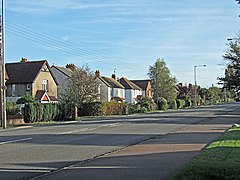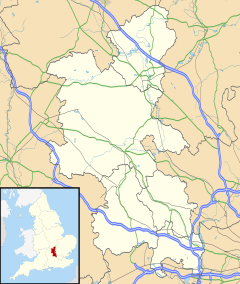world.wikisort.org - United_Kingdom
Stoke Mandeville is a village and civil parish in the Vale of Aylesbury in Buckinghamshire, England. It is located three miles (4.9 km) from Aylesbury and 3.4 miles (5.5 km) from the market town of Wendover. Although a separate civil parish, the village falls within the Aylesbury Urban Area. According to the Census Report the area of this parish is 1,460 acres (5.9 km2).
| Stoke Mandeville | |
|---|---|
 The A413 in Stoke Mandeville, going towards Wendover | |
 Stoke Mandeville Location within Buckinghamshire | |
| Population | 5,825 (2011 Census)[1] |
| OS grid reference | SP835105 |
| Civil parish |
|
| Unitary authority |
|
| Ceremonial county | |
| Region | |
| Country | England |
| Sovereign state | United Kingdom |
| Post town | AYLESBURY |
| Postcode district | HP21, HP22 |
| Dialling code | 01296 |
| Police | Thames Valley |
| Fire | Buckinghamshire |
| Ambulance | South Central |
| UK Parliament |
|
Stoke Mandeville Hospital, although named after the village, is located on the parish's border with Aylesbury. The hospital has the largest spinal injuries ward in Europe, and is best known internationally as the birthplace of the Paralympic movement; the Stoke Mandeville Games, instituted in the hospital by Sir Ludwig Guttmann in 1948 evolved to become the first Paralympic Games in Rome in 1960, which were also the 9th Stoke Mandeville Games. Stoke Mandeville was also joint host of the 1984 Summer Paralympics with New York, with the wheelchair elements of the Games being held in the village. The village of Stoke Mandeville remains by far the smallest official host of a modern Olympic or Paralympic Games.
The village continues to be known for its association with the Paralympic Games, being part of the Paralympic torch relay in every Games since 2012 (its contribution known as the 'Legacy flame'), and giving its name to the Paralympic Games mascot, Mandeville, in 2012.
History
The village was originally recorded as Stoches in the Domesday Book of 1086, from the Old English word stoc meaning an outlying farm or hamlet. The suffix Mandeville was first recorded in 1284 when the manor was listed as being in the hands of the powerful Norman de Mandeville family.
The former medieval parish church, St Mary the Virgin, unusually stood alone on a damp site 1km from the old village for no apparent reason. Therefore it had been postulated that a Roman mausoleum was present on the site before the church was built.[2] The church was condemned in the mid-20th century and was demolished in January 1966 by the Royal Engineers. In 2018 in preparation for the construction of the HS2 high-speed railway, archaeological excavations began on the site of the old church.[3] As well as excavating the church, the process involved moving the remains of those buried in the churchyard,[3] which dates back to 1080. In September 2021, archaeologists from LP-Archaeology, led by Rachel Wood, announced the discovery of remains on the site of the church. They unearthed a possible square foundation trench enclosed by a circular ditch containing burials and two remarkable Roman statues.[4][5][6] In January 2022 the archaeological excavation of the site, and the discovery of significant Roman statuary and burial urns, was featured in the BBC's Digging for Britain.[7]
The newer red brick parish church of St Mary, consecrated in July 1866 by the Bishop of Oxford, Samuel Wilberforce, remains as the only church in the village apart from the Methodist church in Eskdale Road.
Stoke Mandeville was also the location of the Stoke Mandeville Games, which first took place in 1948 thanks to doctor Ludwig Guttmann and are now known as the IWAS World Games. The Games, which were held eight times at Stoke Mandeville, were the inspiration for the first Paralympic Games, also called The Stoke Mandeville Games, which were organised in Rome in 1960. The wheelchair aspects of the 1984 Paralympics were also held in the village. The London 2012 Summer Paralympics mascot, Mandeville, was named after the village due to its legacy with the Games. Stoke Mandeville Stadium was developed alongside the hospital and is the National Centre for Disability Sport in the United Kingdom, enhancing the hospital as a world centre for paraplegics and spinal injuries.
On 13 May 2000, the new Stoke Mandeville Millennium village sign[8] was unveiled. It stands on a small brick plinth on the green outside the primary school. The sign shows colourful images on both sides of aspects of village life over the centuries.
Transport
Stoke Mandeville railway station is on the London to Aylesbury Line between Aylesbury station and Wendover station, served by Chiltern Railways, which terminates at Aylesbury Vale Parkway northbound and London Marylebone southbound.[9] Arriva Shires & Essex number 50 bus also serves the area on Station Road, as do services 164 and 300 – which stops in the centre of the village.[10] High Speed 2 passes to the southwest of the village, but doesn't stop.
Education
Stoke Mandeville Combined School is a mixed community school which takes children from the age of four through to the age of eleven. (Year r – 6) The school has approximately 220 pupils. It also has a hearing impaired department, which currently helps up to 15 children through their school day.
Gallery
- The back of Stoke Mandeville Combined School
- Stoke Mandeville Combined School Balloon Release Event
References
- Neighbourhood Statistics 2011 Census, Accessed 3 February 2013
- "Notes" (PDF). Records of Buckinghamshire. 17 (part 5): 417. 1965. Retrieved 5 May 2021.
- "Stoke Mandeville: HS2 to move 3,000 bodies from medieval churchyard". BBC News. 5 May 2021. Retrieved 5 May 2021.
- "Walls of Possible Anglo-Saxon Church Unearthed in England – Archaeology Magazine". www.archaeology.org. Retrieved 12 September 2021.
- "Archaeologists discover evidence of Anglo-Saxon church". HeritageDaily – Archaeology News. 8 September 2021. Retrieved 12 September 2021.
- "HS2: Anglo-Saxon church found at Stoke Mandeville excavation site". BBC News. 8 September 2021. Retrieved 12 September 2021.
- "BBC iPlayer - Digging for Britain - Series 9: Episode 2". Bbc.co.uk. Retrieved 20 May 2022.
- "Millennium sign". radiolondon.co.uk. Retrieved 8 April 2018.
- "Trains to Stoke Mandeville Station – Times – Chiltern Railways". www.chilternrailways.co.uk. Retrieved 8 April 2018.
- "Arriva Bus". www.arrivabus.co.uk.
External links
 Media related to Stoke Mandeville at Wikimedia Commons
Media related to Stoke Mandeville at Wikimedia Commons- Stoke Mandeville Stadium
- Stoke Mandeville Combined School website
- Stoke Mandeville Guide
На других языках
[de] Stoke Mandeville
Stoke Mandeville ist ein Ort mit rund 6000 Einwohnern in Buckinghamshire, England.- [en] Stoke Mandeville
[ru] Сток-Мандевилл
Сток-Мандевилл (англ. Stoke Mandeville) — деревня (англ. village) и община (англ. civil parish) в британском графстве Бакингемшир в составе района Эйлсбери-Вейл поблизости от его административного центра Эйлсбери на юге центральной Англии. Считается родиной паралимпийского движения благодаря работавшему в Сток-Мандевиллской больнице города Эйлсбери нейрохирургу Людвигу Гуттману (годы жизни 1899—1980), — инициатору проведения «Сток-Мандевиллских игр колясочников».Другой контент может иметь иную лицензию. Перед использованием материалов сайта WikiSort.org внимательно изучите правила лицензирования конкретных элементов наполнения сайта.
WikiSort.org - проект по пересортировке и дополнению контента Википедии


